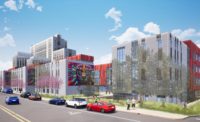With a focus on customized delivery methods, CannonDesign is employing its expertise in adaptability to meet evolving client needs—from finding forward-looking solutions to meet new COVID-19 standards to designing the country’s first-of-its-kind transitional campus to treat the substantial vulnerable and homeless population of Los Angeles.
With offices in Irvine, Calif., Los Angeles, San Diego and San Francisco, CannonDesign’s 2019 regional revenue in California and Hawaii jumped 18% in 2019 to $37.8 million, in part due to major health care projects in California, including the $110-million Oroville Hospital Tower Addition and the Thompson Autism Center at the Children’s Hospital of Orange County. While health care accounted for 37% of the firm’s regional revenue, 42% came from education work.
Praful Kulkarni, director of integrated services at CannonDesign, credits the firm’s success to its central goal: to create a diverse model using different delivery methods, depending on owner preference and project needs.
“The reason we believe we can do something that is unique is because of our integrated services model,” says Kulkarni, also the founder of Gkkworks, a customized design firm acquired by CannonDesign two years ago. That model allows for flexibility in altering plans through innovation and for continual client collaboration with designers, constructors and engineers.
“When you have construction input right from the beginning, the ideation to execution piece starts to work much, much better,” says Kulkarni.
He adds that integrated delivery brings cost and schedule certainty, challenging the perception that construction costs and timelines often increase after a project starts. “We can really put a major crimp in that perception by going to these integrated services models,” he says.
Modular Design
Further flexibility comes from CannonDesign’s subsidiary ModularDesign+, a strategic partner that creates customizable, prefabricated, modular structures like hotel rooms or medical exam rooms. They are built at the company’s Kansas City and Dallas locations, then shipped to sites for installation.
“Not only do you have an opportunity, in a controlled setting, to produce high-quality modules and then save the time on the site—rather than doing stick-build construction—[by having] those modules come in and plug in on a timely basis to reduce the construction time frames,” says Kulkarni. He says the firm is considering opening fabrication shops in Southern California.
CannonDesign’s design-build and modular capabilities are the main reasons Los Angeles County chose the firm to work on its innovative Restorative Care Village. Located on the Los Angeles County+University of Southern California Medical Center (LAC+USC) campus, the Restorative Care Village will help vulnerable residents—60,000 of whom are homeless—navigate interrelated needs such as substance abuse, mental health problems, job training and housing in one development.
“The reason we believe we can do something that is unique is because of our integrated services model.”
– Praful Kulkarni, Director of Integrated Services, CannonDesign
The campus hosts two key facilities: a four-story, 96-bed recuperative care center for persons discharged from an inpatient hospital who lack a supportive place to live. The other is a 64-bed, four-building residential treatment program that serves as a short-term alternative to hospitalization for mental health needs.
Jo Ann Yanagimoto-Pinedo, deputy director of strategic initiatives for the Los Angeles County Dept. of Mental Health (DMH), oversees the county’s restorative care projects and says CannonDesign met the challenge to design within a defined, landlocked space with requirements dictated by licensing. Another major challenge was earning buy-in from the community, which was initially reluctant to have a recovery center in the neighborhood.
“We really had to react and respond because the community wanted this to be a building that felt like part of their neighborhood and part of their culture, so we had to work that balance,” says David Hunt, CannonDesign’s Southern California health practice leader.
One of the community’s greatest concerns was to ensure the RCV would pay homage to the architecture of the Los Angeles County General Hospital, one of the city’s most recognizable Art Deco buildings and an iconic landmark that overlooks the USC campus.
CannonDesign veered from the original scoping document and radically changed the concept from a volumetric solution to a standard steel frame with prefabricated rooms. The new design solution was based on price, interior and exterior design and community input.
It also incorporated aspects of the hospital’s facade into the buildings’ street-facing exteriors. After the team visited neighborhood plazas and murals, they decided to ask local artists to create their works on metal panels in the interior courtyard.
“It’s an interesting blend—the outward facing reflecting the history of USC and the inside reflecting the neighboring culture,” says Hunt. Construction documents are currently with the city for permitting, and construction is slated to being in June, with completion in March 2021.
“They’ve been incredibly participatory, and it requires a certain amount of patience to work with the community, not in a negative sense, but being sensitive to people who may not have an architecture or health background, but also cultural sensitivity,” says Yanagimoto-Pinedo.
“They really have proven to be a great partner with the county because we are the safety net. When people have no resources, no programs, no services, nowhere to go, we are that safety net.”
That flexibility and adaptabability is serving CannonDesign, and its clients, well in the new age of COVID-19, which is “creating its own issues,” says Kulkarni.
He points to the firm’s work on Los Angeles International Airport’s Midfield Satellite Concourse (MSC) project, part of Los Angeles World Airports’ $8-billion capital improvement program.
The MSC is a remote airport bussing operation and access tunnel to the airport’s Bradley West Terminal. Major issues arose on the site because workers need to be bussed to the secure site. With social-distancing standards in place, that meant a 20% capacity reduction for each trip.
“All those kinds of things start to occur on the construction end, and that has an impact on efficiency,” Kulkarni says.
Craig Hamilton, a principal at CannonDesign for 22 years who specializes in education projects, says that California may be better positioned to adapt to COVID-19 accommodations because of the Golden State’s famous fair weather and barrier-breaking designs that consider disability and gender identity. Those designs have already led to wider hallways, single-use bathrooms and outdoor open-air spaces that connect buildings and campuses.
Hamilton notes the firm’s recently completed work at Ohlone Community College in Fremont, Calif. The firm designed a 188,000-sq-ft group of buildings to replace facilities built in the 1970s.
“We designed the rooms not at full capacity according to what the state of California would want, but at lesser capacity so they could grow into the buildings,” says Hamilton. He adds that similar designs may allow schools to open more easily at lower capacity than those with older buildings.
New COVID-19 considerations include the need for more space, separate bathrooms and touchless entries, water fountains and sinks. Hamilton says that bond-funded education projects are moving forward, including a science and math facility at Santa Monica Community College.
“All of our educational clients are concerned about revenue stream and who is going to show up in fall,” says Hamilton.
He adds that community college enrollment typically spikes when the economy falls. “The community colleges are most adept at adapting to local jobs markets and trends, but all of that is the great unknown.”
Nonetheless, Kulkarni says CannonDesign was ahead of its sales goals through April, the majority of them met through health care work. “We did have one or two jobs go on hold in the meantime, but overall consensus is that we are going to be fine in terms of what this year looks like,” he says.
“We will have implications in commercial and possibly the civic side as the revenues start to decline coming into the state, county and local governments—that remains to be seen—and we are preparing for that. We think this is going to be a two-year slog to get back to our current levels.”
With all of the hiccups caused by COVID-19, Kulkarni points to a positive side effect: the camaraderie created by blurring the lines between personal space and work.
“We are getting to see what people’s homes look like,” he says. The firm had already created a remote work-from-home plan in January. “Efficiency actually went up. We met some major deadlines.”







Post a comment to this article
Report Abusive Comment